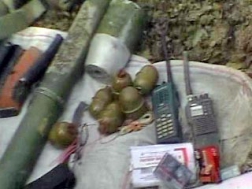
Gimry Becomes Target of Dagestan Government Reprisals Again
Publication: Eurasia Daily Monitor Volume: 10 Issue: 90
By:

After nearly a month-long counter-terrorism operation in the Dagestani village of Gimry, residents have complained about the devastation government agents inflicted on their homes. Shamil Magomedov, the head of Untsukul district, of which Gimry is a part, told the Kavkazsky Uzel (Caucasian Knot) website: “We have received 420 complaints. Ten homes were blown up. Twenty-six homes were significantly damaged. We are working with each person and will try to help as much as we can.” Many villagers complained that their homes were looted in their absence. Despite the official end of the special operation, an 8 p.m. to 7 a.m. curfew has been imposed in the village. Sick people were removed from the local hospital, which became home to a police expeditionary force. The local school is still not functioning as normal. Non-residents, including journalists, are not allowed to enter the village. Many residents of Gimry, which has a population of nearly 5,000, have returned to their homes. After a counter-terrorism regime was imposed in the village in April, the authorities moved its entire population to the nearby shanty town Vremenny (Temporary) for the duration of the special operation. The counter-terrorism regime resulted in the killing of three suspected militants on April 12 (https://www.kavkaz-uzel.ru/articles/223986/). The rest of the time, it appears that the government kept the villagers away from their homes as a form of collective punishment.
A source in the Dagestani interior ministry denied there were cases of villagers’ property being looted. The source said that some houses were indeed blown up because the police found improvised explosive devices (IED) in them and had to detonate them because they could not be safely removed. The villagers say that their houses were blown up because the police tried to conceal the looting. While the police killed only three militants, they apparently destroyed or inflicted significant damage to 36 homes, so there seems to be serious discrepancy between the figures. The Dagestani police source innocuously gave away the government’s frustration with the village when speaking of the Gimrians’ protests: “They are dissatisfied with being pressured. But, on the other hand, is it normal, when residents [of Gimry] shelter bandits and shoot government forces in the back while they are conducting a special operation?” (https://ria.ru/defense_safety/20130510/936737543.html#ixzz2T2NsXGr5).
The counter-terrorism operation in Gimry was strikingly reminiscent of the classic reprisals by Russian forces in the North Caucasus in the 19th century. After the government forces intensively shelled the forest adjacent to Gimry on the night of April 12, they reportedly summoned the head of the village, Aliaskhab Magomedov, and another villager. Both men were told to put on helmets with built-in video cameras and visit the shelled section of the forest. They were required to identify and film any slain militants. According to the Chernovik newspaper, at first the villagers refused to go into the forest, but a government agent threatened them, saying: “Either you go or there will be not three, but five corpses.” The two villagers had no choice but to obey the orders. An estimated 400 armored vehicles and 6,000 personnel made up of police, security service and military forces were deployed to the site of the special operation in Gimry (https://chernovik.net/content/respublika/sindrom-2007).
The acting president of Dagestan, Ramazan Abdulatipov, supported the collective punishment tactics in Gimry, blaming republican officials for failing to make the general population oppose the insurgents. Abdulatipov proposed providing the young generation of Dagestanis with better recreational opportunities and replacing Islamic cultural elements with ethnic Dagestani elements to fight the spread of radical Islam and insurgency. Abdulatipov noted that Dagestan’s poor business climate and absence of minimal conditions for entrepreneurship had stalled the republic’s development (https://ndelo.ru/politika-5/1185-vesennie-tezisy).
Meanwhile, the government seems unsure of what happened to the most notorious leader of Gimry’s jamaat, Ibragim Gajidadaev. News agencies reported that Gajidadaev was killed in a special operation in the Makhachkala suburb of Semender in March. Later, DNA expertise could not confirm his death. Also notable is the fact that a close associate of Gajidadaev, Abdula Zaguliev, who was also declared dead in Semender in March, was actually killed in April in a massive artillery barrage targeting the Gimry forest and subsequently identified (https://chernovik.net/content/respublika/sindrom-2007). The violence is not limited to the village of Gimry. In the second such incident in less than two weeks, a police officer and a civilian passenger in his car were killed by unidentified assailants on May 11 (https://ria.ru/incidents/20130511/936849205.html). Also, the tactic of blowing up the homes of suspected rebel and even rebel sympathizers is apparently spreading across the republic, with such incidents being reported in the city of Buinaksk (https://www.kommersant.ru/doc/2185376).
Gimry’s travails show that the government’s rapport with the local population has worn so thin that it only has collective punishment and terror to provide a semblance of control over parts of the republic. Although the new republican government remains relatively popular and the public’s hopes are still high, the question is whether Abdulatipov has much skill in security matters. If he does and is consciously adopting harsh tactics in dealing with the social base of the insurgency, a backlash by Dagestan’s general population against his government remains only a matter of time.




